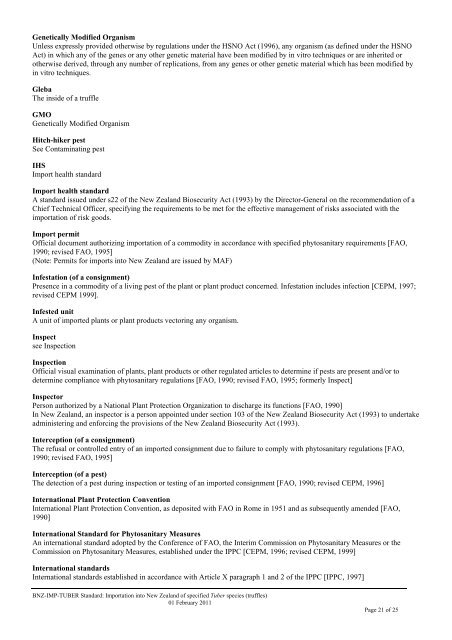BIOSECURITY NEW ZEALAND STANDARD BNZ-IMP-TUBER ...
BIOSECURITY NEW ZEALAND STANDARD BNZ-IMP-TUBER ...
BIOSECURITY NEW ZEALAND STANDARD BNZ-IMP-TUBER ...
You also want an ePaper? Increase the reach of your titles
YUMPU automatically turns print PDFs into web optimized ePapers that Google loves.
Genetically Modified Organism<br />
Unless expressly provided otherwise by regulations under the HSNO Act (1996), any organism (as defined under the HSNO<br />
Act) in which any of the genes or any other genetic material have been modified by in vitro techniques or are inherited or<br />
otherwise derived, through any number of replications, from any genes or other genetic material which has been modified by<br />
in vitro techniques.<br />
Gleba<br />
The inside of a truffle<br />
GMO<br />
Genetically Modified Organism<br />
Hitch-hiker pest<br />
See Contaminating pest<br />
IHS<br />
Import health standard<br />
Import health standard<br />
A standard issued under s22 of the New Zealand Biosecurity Act (1993) by the Director-General on the recommendation of a<br />
Chief Technical Officer, specifying the requirements to be met for the effective management of risks associated with the<br />
importation of risk goods.<br />
Import permit<br />
Official document authorizing importation of a commodity in accordance with specified phytosanitary requirements [FAO,<br />
1990; revised FAO, 1995]<br />
(Note: Permits for imports into New Zealand are issued by MAF)<br />
Infestation (of a consignment)<br />
Presence in a commodity of a living pest of the plant or plant product concerned. Infestation includes infection [CEPM, 1997;<br />
revised CEPM 1999].<br />
Infested unit<br />
A unit of imported plants or plant products vectoring any organism.<br />
Inspect<br />
see Inspection<br />
Inspection<br />
Official visual examination of plants, plant products or other regulated articles to determine if pests are present and/or to<br />
determine compliance with phytosanitary regulations [FAO, 1990; revised FAO, 1995; formerly Inspect]<br />
Inspector<br />
Person authorized by a National Plant Protection Organization to discharge its functions [FAO, 1990]<br />
In New Zealand, an inspector is a person appointed under section 103 of the New Zealand Biosecurity Act (1993) to undertake<br />
administering and enforcing the provisions of the New Zealand Biosecurity Act (1993).<br />
Interception (of a consignment)<br />
The refusal or controlled entry of an imported consignment due to failure to comply with phytosanitary regulations [FAO,<br />
1990; revised FAO, 1995]<br />
Interception (of a pest)<br />
The detection of a pest during inspection or testing of an imported consignment [FAO, 1990; revised CEPM, 1996]<br />
International Plant Protection Convention<br />
International Plant Protection Convention, as deposited with FAO in Rome in 1951 and as subsequently amended [FAO,<br />
1990]<br />
International Standard for Phytosanitary Measures<br />
An international standard adopted by the Conference of FAO, the Interim Commission on Phytosanitary Measures or the<br />
Commission on Phytosanitary Measures, established under the IPPC [CEPM, 1996; revised CEPM, 1999]<br />
International standards<br />
International standards established in accordance with Article X paragraph 1 and 2 of the IPPC [IPPC, 1997]<br />
<strong>BNZ</strong>-<strong>IMP</strong>-<strong>TUBER</strong> Standard: Importation into New Zealand of specified Tuber species (truffles)<br />
01 February 2011<br />
Page 21 of 25
















